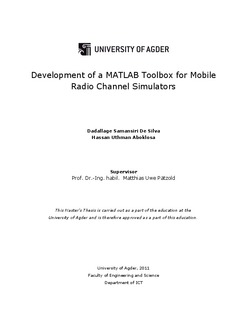| dc.description.abstract | A profound knowledge of mobile radio channels is required for the development, evaluation, and
also assessment at practical conditions of present and future mobile radio communication
systems. The modelling, analysis, and simulation of mobile radio channels are important sub area
since the initiation of mobile communications. In addition to that knowledge of channel
behaviour in mobile radio communication is extensively recommended for the study of
transmitter/receiver performances. Our intention in this master's thesis is to develop various
kinds of mobile fading channel simulators using MATLAB and embed them into MATLB
software as a toolbox.
Implemented channel simulators were combined into a user-friendly Matlab toolbox from which
users can easily select well-known channel models to test and to study the performance of
mobile communication systems. The help file was developed based on HTML. It gives better
support for the new users to work on the developed channel simulators, run the test procedures as
well as parameter computation. The help file consistent with other supplementary programs like
computation of PDF and CDF for different distributions, Rice simulation model, extended
Suzuki process type I and II simulator etc. In addition to that each program consists with
guidelines embedded with the source code. The help file web interfaces are listed in Appendix-
1.The toolbox can be integrated into the new release of Matlab software.
The toolbox contains channel simulators for simulating non-stationary land mobile satellite
channel, spatial shadowing processes, MIMO channels, multiple uncorrelated Rayleigh fading
channels, mobile to mobile channel, frequency hopping channels etc. We developed set of test
procedures, such as the autocorrelation function ACF, average duration of fades ADF, the
probability density function PDF, and the level-crossing rate LCR etc., in order to test and to
confirm the correctness of the implemented channel simulators. Proposed new algorithms to
compute the model parameters of the channel simulators were also implemented in the toolbox to
enable the parameterization of the channel simulators under specific propagation conditions.
Finally, “how can a channel simulator be tested?” have been address in the thesis as a research
question. It was based on the comparison of simulation results with the measured model or the
reference model under different scenarios. In addition to that selection of the simulation time
duration, sampling rate and size of the samples were considered. Developed test procedures were
helped to assess the implemented channel simulators. | en_US |
